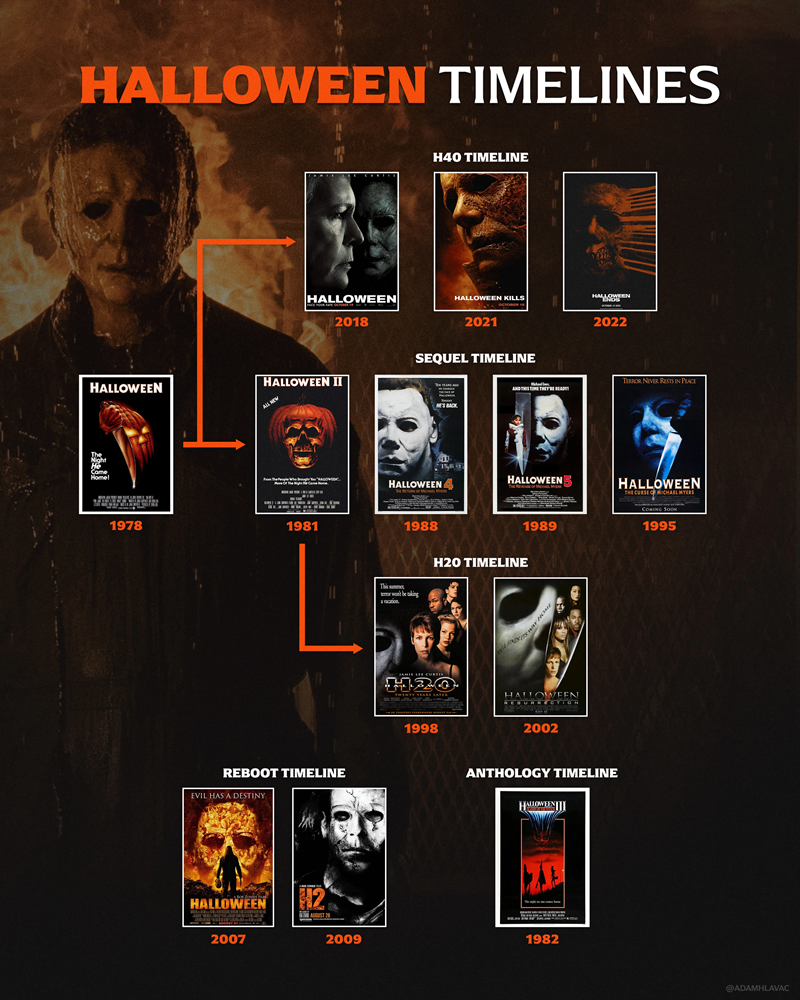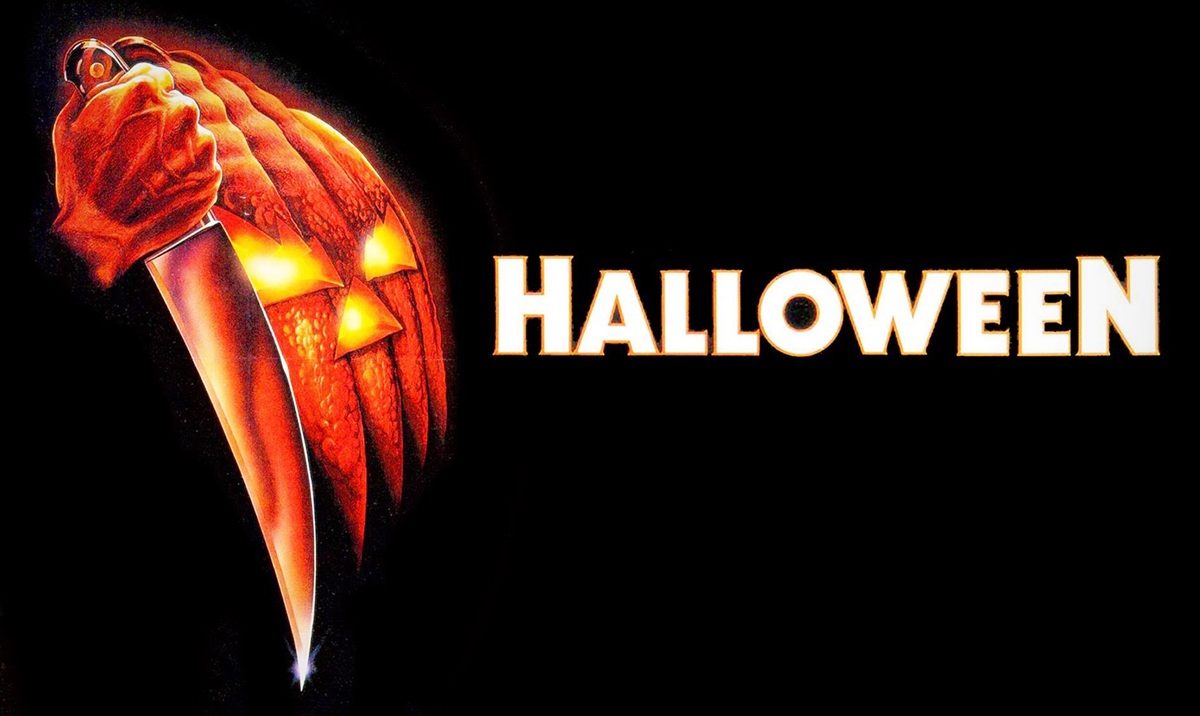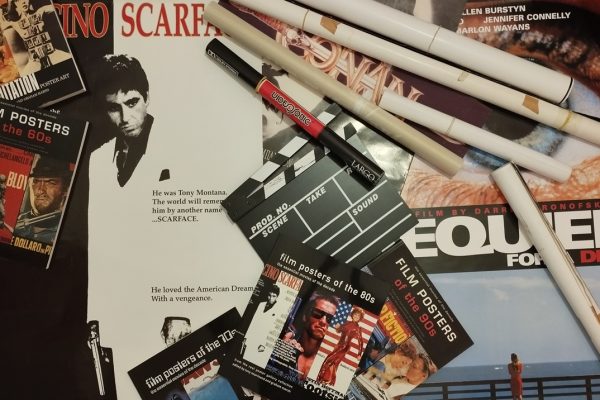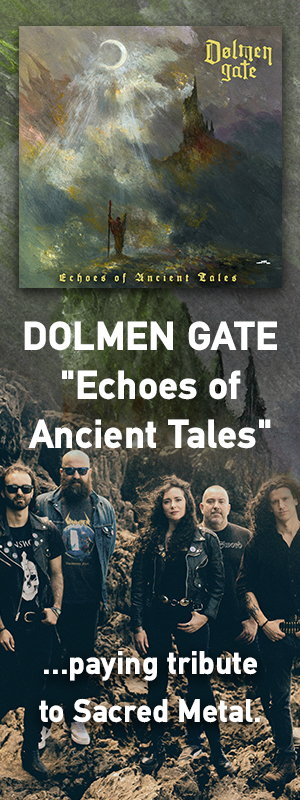Halloween (1978) is the mother of American slasher films, even if four years previous to that, there was already Tobe Hooper’s The Texas Chainsaw Massacre and Bob Clark’s Black Christmas (a Canadian production). Slasher films already had a tradition, mainly because of the Italian giallo films, but it was John Carpenter’s movie and Sean S. Cunningham’s Friday the 13th (1980), the spark for the explosion of slasher films in the ’80s.
We can write a book about the story of the Halloween movies, since almost every film has a huge background about how it was finally completed, the many changes in people involved, the changes and the ideas that were considered but never used. However, we will try to be short and present a glimpse to a story of films and characters that became icons of pop culture.
Let’s celebrate the horror.
The original Halloween film was directed by John Carpenter (who also wrote the music), co-written by John Carpenter and Debra Hill, and produced by Debra Hill. Debra Hill started her career a few years earlier and met Carpenter during his film Assault on Precinct 13 as a script supervisor. For the Halloween script they wrote together, Hill came up with the plot around the character of Laurie Strode (played by Jamie Lee Curtis) and Carpenter came up with the plot around the character of Dr. Samuel Loomis (played by Donald Pleasence). The script was written in just 10 days. Carpenter and Hill were in a relationship at the time and kept working together on other films too, such as The Fog (1980) and Escape from New York (1981). Debra Hill died of cancer in 2005.
Halloween was handled by the independent production company Compass International Pictures and Irwin Yablans as the executive producer, with Moustapha Akkad financing. The film’s budget was $300,000, it premiered on October 25, 1978, and grossed $70 million, becoming one of the most successful and profitable independent movies. John Carpenter was paid just $10,000 for directing and writing the film, plus composing the music, but he had full creative control. He also agreed to keep rights to 10% of the film’s profits.
Carpenter hired Tommy Lee Wallace as production designer, art director and any other job he could do because of the low budget. Wallace was responsible for the iconic mask of Michael Myers. The original mask’s cost was $2, and it was a mask of Captain Kirk from the Star Trek series (performed by actor William Shatner). Wallace just cut and widened the eye-holes, painted the mask white and changed the hair style.
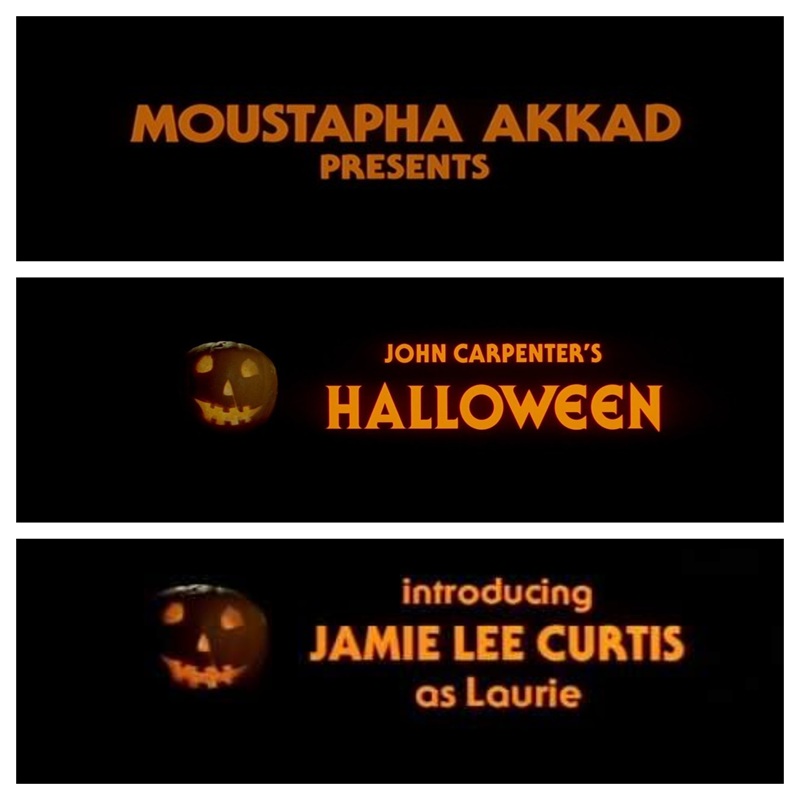
The night HE came home!
The film starts on the night of Halloween in 1963. In the town of Haddonfield, a kid stabs to death his teenage sister. The kid’s name is Michael Myers. Fifteen years later, Myers escapes from the sanitarium and the killing begins. The story is simple, but Carpenter’s camera (often used as the killer’s eyes) and the minimalistic but effective and scary music, along with the iconic shape of the character known as Michael Myers, became a milestone in horror pop culture. The movie was filmed in just 20 days over a 4-week period in May 1978.

The slasher and horror films that dominated the ’80s in the United States are often mentioned by reviewers, scholars and film historians, as stories that connect danger and eventually death, with the teenagers’ sexuality, including also nudity and violence against women. Both writers of the original Halloween film, John Carpenter and Debra Hill (who is a woman), never thought about it at the time of writing and have mentioned that it was unintentional. Still, though, that kind of story became a template for countless slasher, splatter and horror films that followed.
Jamie Lee Curtis was a young, unknown actress at the time, even if she was the daughter of actors Tony Curtis and Janet Leigh. She wasn’t the first choice for the main character, but since she was the daughter of Psycho‘s actress Janet Leigh (the classic Alfred Hitchcock film of 1960), Debra Hill thought it would work and offer some extra publicity. Later on, they also became close friends. Donald Pleasence was already a veteran, but he wasn’t the first choice for the role of Dr. Samuel Loomis. Horror icons such as Peter Cushing and Christopher Lee were considered but declined because of the low fee. Of course, they regret it.
Upon its release, Halloween was praised by critics and years after its release, it is considered as one of the best and most influential horror and slasher movies in the history of cinema.

He came back to finish what they’ll never forget…
The next film, Halloween II (1981), continues from the same night the first movie ended, but John Carpenter never sat in the director’s chair again. Dr. Loomis continues hunting Michael Myers and the killer is following Laurie Strode to the hospital. It was directed by Rick Rosenthal but John Carpenter and Debra Hill wrote and produced the sequel. With a bigger budget and the production company of Dino De Laurentiis, the film had again a big profit but received mixed reviews. Both Jamie Lee Curtis and Donald Pleasence returned to the leading roles and the main plot twist was that Laurie Strode is Michael Myers’ sister. Halloween II had more gore, violence and nudity than the first movie. Many people believe that this happened because of the new director, but Rosenthal has mentioned that this was Carpenter’s input, something he didn’t agree with. Carpenter believed that the movie needed more graphic violence to match the slasher and splatter films of its time. The film ends with Michael Myers shot in the eyes and then surrounded by flames and collapsing.

The night no one comes home.
Halloween III: Season of the Witch (1982) keeps only the title as a connection to the franchise. Michael Myers or previous characters are absent. The story involves witchcraft and was supposed to be the beginning of a series focused on the night of Halloween. It didn’t work for fans and critics at the time, even if the movie was profitable. However, over the years it has gained a cult following, just like many other horror films of the ’80s. The third film is written and directed by Tommy Lee Wallace, who worked on the first film, and also was Carpenter’s choice to direct Halloween II but Wallace declined. This film is also produced by John Carpenter and Debra Hill, and Moustapha Akkad appears again, just like the previous and the next films. His name has become synonymous with the franchise, since the movies started with “Moustapha Akkad Presents”. Moustapha Akkad was killed in 2005 in a suicide bomb attack in Amman, Jordan.
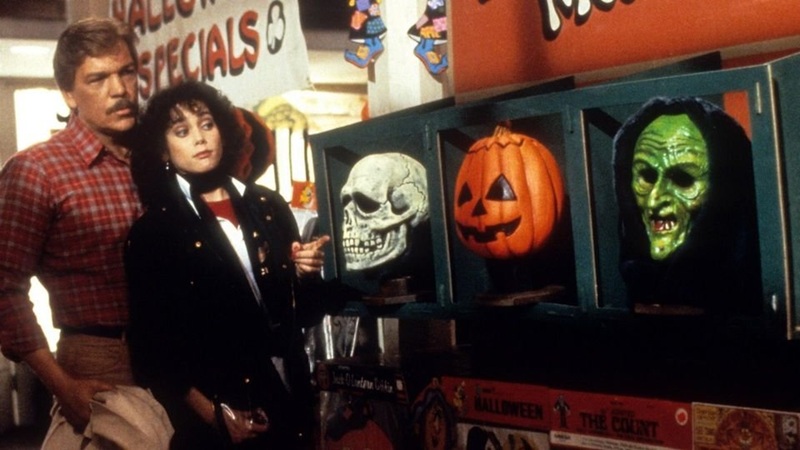
Horror has returned to Haddonfield.
It took a few years, but in October 1988, Halloween 4: The Return of Michael Myers hit the theaters, with the worst mask of the series, the ’80s VHS aesthetics, characters people were familiar with, and an incredible ending despite the fact that the complete film didn’t reach the expectations.
Directed by Dwight H. Little and written by Alan B. McElroy, the film brings back Michael Myers, who appears to be in a coma and he is not dead. He returns to Haddonfield to kill Laurie Strode’s orphaned daughter, while Dr. Loomis (with Donald Pleasence returning to the role) is chasing him again. There was an idea to bring the character of Jamie Lee Curtis back too, but the actress refused, so in the script, Laurie Strode is dead.
While in the film (and the next ones) you have the credit “Based on characters by John Carpenter and Debra Hill”, both Carpenter and Hill sold the rights to Moustapha Akkad and Carpenter declined any involvement with the franchise for many years. His classic music of the “Halloween Theme” was present in all films, but the score for each film was written by other composers. For Halloween II and Halloween III: Season of the Witch, the music was composed by John Carpenter and Alan Howarth, but for the next three films, music was composed just by Alan Howarth. Halloween 4: The Return of Michael Myers was also profitable, but the reviews were mostly negative in its time.
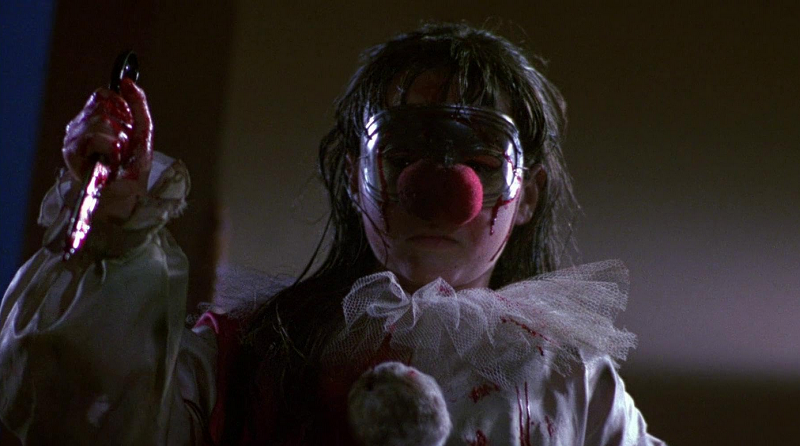
Halloween 5: The Revenge of Michael Myers (1989) continues from the point the fourth film ended and if you ignore the plot holes you have just a usual ’80s horror film without scare-jumps but the usual body-count and blood-level. Moustapha Akkad wanted the same director and writer as the previous film, but both refused to return, so this movie was directed by Dominique Othenin-Girard, and it was written by Michael Jacobs, Dominique Othenin-Girard and Shem Bitterman. While it still had some profit, it was the lowest-grossing film in the franchise at the time and received mostly negative reviews. The end of the film was confusing but made sense with the next installation of the franchise.

It took a few years for the next film, Halloween: The Curse of Michael Myers (1995), to appear, introducing supernatural elements and a brief connection with the witchcraft of the third film, but we were still far from a great horror film. Directed by Joe Chappelle and written by Daniel Farrands, it was the last time that Donald Pleasence appeared in the role of Dr. Loomis since he died before the theatrical release of the film. The movie took a long time to be completed, including reshoots and changes, and met a poor reception from fans and critics.

Those last four films might appear uneven and frustrating, including also all the ’80s horror clichés, but they have their own sacred place in the heart of some fans of the franchise. Some of them might be disappointing, or mediocre, or just guilty pleasures, but they all have their moments and their own part in the franchise, while they got a second round of success as low-rent videotapes.
It’s going to be one hell of a family reunion.
In 1998, there was an attempt for a rebirth of the franchise with Halloween H20: 20 Years Later that ignores the previous films and continues after the events of the night of the first two films, creating a new continuity. Jamie Lee Curtis is back in the role of Laurie Strode, who has faked her death and taken a new identity so she could continue her life. Michael Myers has been missing since the fire at the end of Halloween II and appears 20 years later. Directed by Steve Miner, it was written by Robert Zappia and Matt Greenberg but until its competition, there were already many different ideas that never materialized. This new continuation was handled by the Dimension Films of Harvey and Bob Weinstein. With Jamie Lee Curtis back, John Carpenter was considered as the director and the horror master agreed to do it under the term that there were going to be two more films and also demanded a fee of $10 million. His request was mostly because of his fallout with Moustapha Akkad, who never paid Carpenter the revenue that was agreed from the first film. The Weinstein brothers didn’t agree. In the end, the film was a success, grossing $75 million at the box office, on a budget of $17 million, since it was helped by the hype and commercial success that modern slasher films such as Scream (1996), Scream 2 (1997) and I Know What You Did Last Summer (1997) already had. Those films were written by Kevin Williamson, who also helped on the script of Halloween H20: 20 Years Later without a credit.
Halloween: Resurrection (2002) continues three years after the events of the previous film with a connection just for the first minutes, and later it goes to a different story inspired by modern slasher films, but it’s a complete failure. Jamie Lee Curtis appears at the beginning of the film, just to be killed by Myers.
In 2007 and 2009, Rob Zombie as a director offered a remake of the first two films with his modern Halloween and Halloween II films. His approach didn’t really work, especially with the first movie where he is introducing for a long time Michael Myers as a child, so the viewers are connected mostly with the child’s face than with the evil shape we knew. Starting with KISS’ “God of Thunder” wasn’t enough.

40 years later, Evil returns home – You don’t believe in the Boogeyman? You should.
In 2018, another Halloween film appears, the beginning of a new trilogy by Blumhouse Productions, that continues directly from the first film, ignoring the ’80s arc and the previous installation (again with Jamie Lee Curtis), starting a new continuation/timeline. That trilogy continued with Halloween Kills (2021), having the greatest slashed-body-count of the franchise and ended with the controversial Halloween Ends. In this timeline, Michael Myers was arrested in 1978, spending 40 years in a sanitarium. Then he escapes and returns to Haddonfield…
This new trilogy is directed by David Gordon Green, and produced by Malek Akkad (son of Moustapha and new owner of the rights to the franchise), Jason Blum and Bill Block. John Carpenter returns, composing music with Cody Carpenter and Daniel Davies. Halloween was written by Jeff Fradley, Danny McBride and David Gordon Green. Halloween Kills was written by Scott Teems, Danny McBride and David Gordon Green. Halloween Ends was written by Paul Brad Logan, Chris Bernier, Danny McBride and David Gordon Green. For this new trilogy, John Carpenter returns as executive producer, approving the script and supervising the films. Jamie Lee Curtis was also an executive producer.
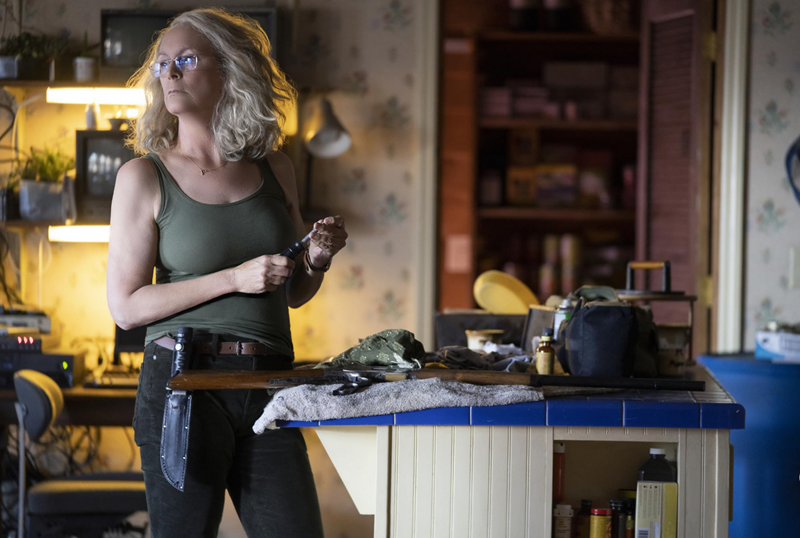
Three generations Strode strong.
An interesting thing in Halloween that is not really mentioned so far, is that we don’t have the classic “final girl” of a horror movie; it is a “final girl” spanning three generations. There are three final girls here: Laurie Strode (Jamie Lee Curtis), her daughter Karen Nelson (Judy Greer) and her granddaughter Allyson Nelson (Andi Matichak). The energy and the interaction of the female characters is absolutely brilliant. This timeline was what Jamie Lee Curtis wanted to do, giving justice to Laurie Strode’s character. Years after filming Halloween H20: 20 Years Later, she has mentioned that she regretted making that film, especially without the involvement of her friend, Debra Hill, but with Halloween (2018) and this new timeline, it appears that everything is coming full-circle.
Halloween, the first film of the new trilogy and timeline, was a major box office success, grossing over $250 million with just a $10 million budget.
“You can’t kill the boogeyman”
Halloween builds suspense and tension, but Halloween Kills adds action, starting from the bloody opening scene. Michael Myers is not creepy here. This is his bloodier and most brutal version. Critics mostly disagreed, considering it mostly a “bloody mess” but at least they got the “bloody” thing. And if you believe that you already read the word “bloody” too many times, that’s what Halloween Kills is all about.
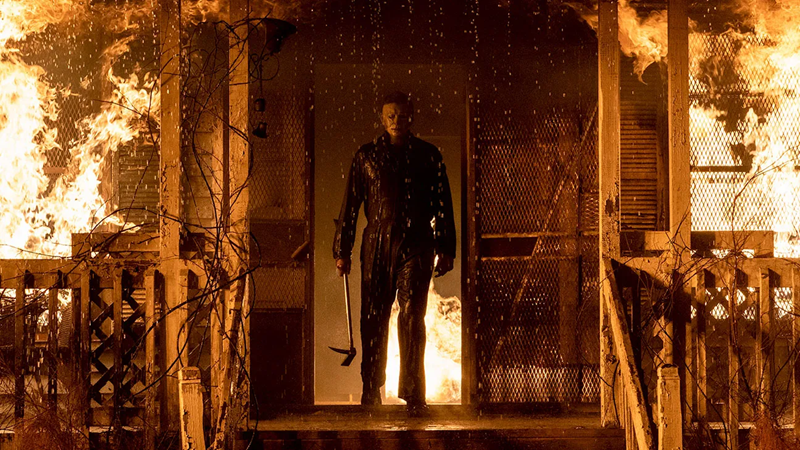
Evil dies tonight.
While Halloween Kills satisfies Michael Myers fans, Halloween Ends comes as it wants to destroy everything the first and second part of that new trilogy presented regarding his character. However, just like the previous two films of this trilogy, Halloween Ends also has excellent production value, even if many people believe it fails in the story and how it handles its characters. If Halloween (2018) is suspenseful and Halloween Kills is gruesomely bloody, Halloween Ends seems unfocused. But that’s on the surface, because underneath, it shifts the focus from Michael Myers to Laurie Strode and her family ties, adding also that evil never dies; it just changes and also affects everyone in the city of Haddonfield. In the end, Myers is dead, but Laurie keeps his mask.
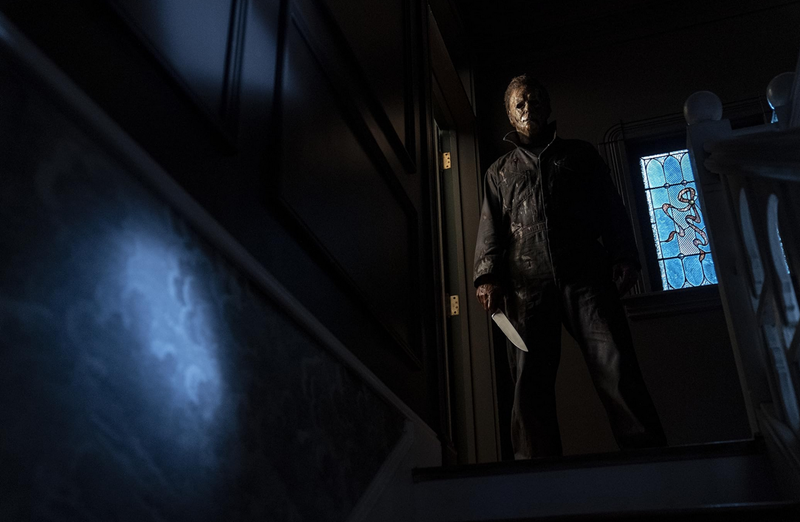
RANKING:
01. Halloween (1978)
02. Halloween Kills (2021)
03. Halloween (2018)
04. Halloween II (1981)
05. Halloween III: Season of the Witch (1982)
06. Halloween H20: 20 Years Later (1998)
07. Halloween Ends (2022)
08. Halloween 4: The Return of Michael Myers (1988)
09. Halloween: The Curse of Michael Myers (1995)
10. Halloween 5: The Revenge of Michael Myers (1989)
11. Halloween: Resurrection (2002)
12. The Rob Zombie remakes
